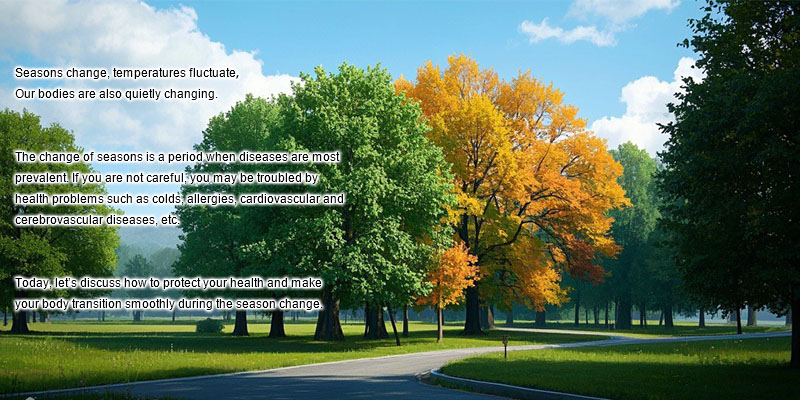The impact of changing seasons on the body
The fluctuation of seasonal temperatures significantly impacts airborne allergen concentrations and respiratory health. As temperatures rise during transitional periods, plants enter accelerated reproductive cycles, leading to increased pollen production – particularly from birch, ragweed, and grass species. Concurrently, warmer conditions create ideal habitats for dust mites (Dermatophagoides species), with their populations thriving in humidity levels above 50% and temperatures between 20-25°C. These biological particulates, when inhaled, trigger immunoglobulin E (IgE)-mediated hypersensitivity reactions in predisposed individuals, manifesting as allergic rhinitis characterized by nasal congestion, rhinorrhea, and sneezing, or more severe bronchial hyperresponsiveness seen in asthma exacerbations.
Furthermore, abrupt thermoregulatory challenges caused by rapid temperature variations induce physiological stress on the respiratory epithelium. The nasal mucosa, normally maintained at 34-36°C, experiences vasoconstriction during cold exposure and vasodilation in warm periods, compromising mucociliary clearance mechanisms. This thermal stress reduces secretory immunoglobulin A (sIgA) production by up to 40% according to climatological studies, substantially weakening the respiratory tract’s first-line immunological defense. The resultant epithelial vulnerability creates optimal conditions for viral pathogenesis – rhinoviruses demonstrate enhanced replication rates in cooler nasal passages (33-35°C versus core body temperature), while influenza virions maintain greater environmental stability in low-humidity cold air. These combined factors elevate population risks for upper respiratory infections by approximately 30% during transitional seasons, particularly affecting pediatric and geriatric populations with less resilient mucosal immunity.
Seasonal temperature fluctuations can significantly impact cardiovascular function by altering blood vessel constriction and dilation patterns, leading to unstable blood pressure levels. During transitional weather periods, abrupt changes in environmental temperatures trigger repeated adjustments in vascular tone as the body attempts to maintain thermal equilibrium. This physiological stress disproportionately affects individuals with pre-existing conditions such as hypertension (chronically elevated blood pressure) and coronary artery disease (impaired blood flow to heart muscle).
The instability in blood pressure places additional strain on the cardiovascular system, forcing the heart to work harder to circulate blood effectively. For vulnerable populations, this heightened demand can overwhelm compromised cardiac function, substantially elevating the risk of acute cardiovascular complications. These may include angina pectoris (reduced oxygen supply causing chest pain) and myocardial infarction (complete blockage of coronary blood flow leading to heart tissue damage). Medical studies indicate that such temperature-driven hemodynamic instability contributes to a 20-30% increase in cardiovascular emergencies during seasonal transitions, particularly among elderly patients and those with poorly managed chronic conditions.
Seasonal changes in temperature and humidity can temporarily affect the body’s immune function. As the immune system requires time to adjust to shifting environmental conditions, this adaptation period creates a window of vulnerability. If exposed to pathogens like viruses or bacteria during this phase, the body’s defenses may weaken, increasing the likelihood of infections such as colds, flu, or respiratory illnesses. Older adults, young children, and those with chronic health conditions are particularly susceptible during seasonal transitions due to their less resilient immune responses.
Prevention and treatment of common diseases during seasonal changes
Respiratory diseases
1.Strengthen protective measures
During periods of high pollen concentration, try to reduce going out. If you need to go out, wear protective equipment such as masks and glasses to avoid contact with allergens.
2.Keep the air in your home clear
Open windows for ventilation regularly, use an air purifier to filter out allergens in the air, and keep the indoor air clean.
3.Enhance immunity
Improve your body’s immunity and reduce the risk of respiratory infections by eating a proper diet, exercising moderately, and getting enough sleep.
Cardiovascular disease
1.Monitor blood pressure
During the season change, monitor blood pressure regularly to keep abreast of changes in blood pressure. If blood pressure fluctuates greatly, seek medical attention in a timely manner and adjust the dosage of antihypertensive drugs under the guidance of a doctor.
2.Keep warm
Add clothes in time according to weather changes to avoid blood vessel constriction due to cold and increase the burden on the heart.
3.Eat properly
Controlling salt intake and eating more foods rich in potassium, calcium, magnesium and other minerals, such as bananas, spinach, milk, etc., can help maintain stable blood pressure.
Allergic diseases
1.Avoid contact with allergens
Understand your allergens and try to avoid contact. For example, if you are allergic to pollen, reduce the time spent outdoors during the pollen season.
2.Drug prevention and treatment
Under the guidance of a doctor, use anti-allergic drugs reasonably to relieve allergic symptoms. For severe allergic reactions, seek medical attention in time.
Post time: Apr-18-2025




